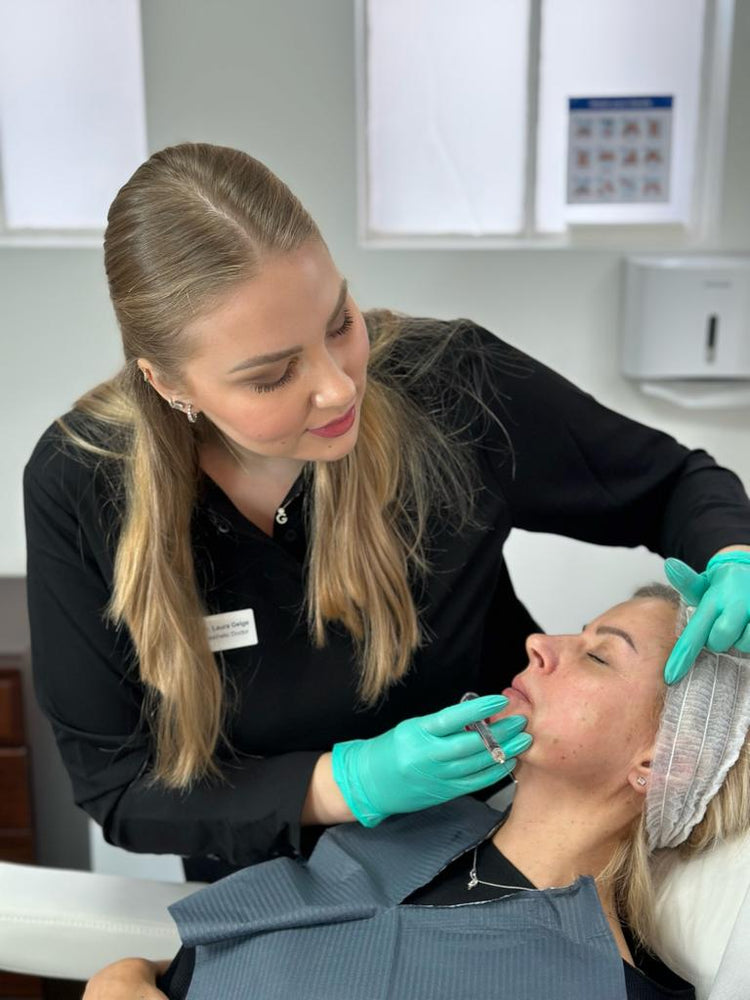How Nasolabial Fold Fillers Restore Lost Volume And Smoothness In London
On May 21, 2025 by Lily CooperThe Science of Nasolabial Folds
The nasolabial fold, also known as the smile line, is a crease that runs from the base of the nose to the corner of the mouth. As we age, these folds become more prominent due to the loss of facial fat and collagen. This can give the face a tired or aged appearance.
Causes of Volume Loss
The nasolabial fold, also known as the smile line, is a crease that runs from the base of the nose to the corner of the mouth. As we age, these folds become more prominent due to the loss of facial fat and collagen. This can give the face a tired or aged appearance.
Dermal fillers are commonly used to address nasolabial fold volume loss, restoring smoothness and contour.
Fillers work by injecting gel-like substances under the skin, plumping up the area and smoothing out wrinkles.
- Loss of Facial Fat: With age, the body produces less collagen and fat, leading to a loss of volume in the cheeks and surrounding areas, accentuating nasolabial folds.
- Collagen Breakdown: Collagen, a protein that provides structure to the skin, naturally degrades over time. This contributes to sagging and wrinkles, including those around the nose and mouth.
- Muscle Activity: Repeated facial expressions, such as smiling and frowning, can also contribute to the deepening of nasolabial folds over time.
The Role of Hyaluronic Acid Fillers
Dermal fillers are a popular solution for addressing the prominent nasolabial folds that often appear with age. These fillers work by injecting hyaluronic acid, a naturally occurring substance in the body, into the skin.
- Hyaluronic acid attracts and retains water molecules, effectively plumping up the treated area and reducing the appearance of wrinkles.
- By restoring lost volume to the nasolabial folds, fillers smooth out the crease and create a more youthful contour.
Procedure and Process
Procedures for addressing nasolabial fold concerns have become increasingly popular in London. These procedures aim to restore facial volume and smoothness, reducing the appearance of aging.
Consultation and Assessment
Nasolabial folds are addressed through a multi-step procedure involving consultation, assessment, and treatment.
During the initial consultation, a qualified practitioner will evaluate the patient’s facial structure, skin condition, and aesthetic goals. They will discuss various filler types and treatment options to determine the most suitable approach for each individual.
A thorough assessment includes analyzing the depth, shape, and severity of the nasolabial folds. The practitioner will also consider factors like the patient’s skin type, medical history, and any medications they are taking.
Based on the consultation and assessment, a personalized treatment plan is developed. This may involve injecting hyaluronic acid fillers strategically along the nasolabial fold to restore volume and smooth out the crease. The amount of filler used will depend on the patient’s individual needs and desired outcome.
Injection Technique
Injection technique is crucial for achieving optimal results with dermal filler treatments for nasolabial folds. Practitioners utilize various techniques to ensure a natural-looking and long-lasting result.

One common technique is the “linear threading” method, where the filler is injected in small boluses along the crease line. This helps create a more subtle and gradual lift, smoothing out the fold without overfilling.
Another technique is the “fanning” method, which involves injecting the filler in multiple directions to distribute it evenly and create a smoother contour.
The practitioner will use their expertise and experience to select the most appropriate technique based on the individual patient’s anatomy and desired outcome.
Recovery and Downtime
Recovery from nasolabial fold filler treatment is typically quick and involves minimal downtime. Most patients can return to their normal activities immediately following the procedure.
Some mild side effects, such as redness, swelling, or bruising, may occur at the injection sites. These usually subside within a few days.
To minimize any discomfort or potential complications, it is important to follow the practitioner’s post-treatment instructions carefully, which may include avoiding strenuous activity, direct sun exposure, and certain skincare products for a specified period.
Benefits of Nasolabial Fold Fillers
In London, nasolabial fold fillers are gaining popularity as a non-surgical solution to restore lost volume and smoothness. As we age, these folds become more prominent, leading to a tired or aged appearance. Dermal fillers offer a way to address this concern by injecting hyaluronic acid, a naturally occurring substance in the body, which plumps up the skin and smooths out wrinkles.
Improved Appearance
Nasolabial fold fillers are a popular choice for addressing prominent nasolabial folds that often appear with age. These fillers work by injecting hyaluronic acid, a naturally occurring substance in the body, into the skin.
- Hyaluronic acid attracts and retains water molecules, effectively plumping up the treated area and reducing the appearance of wrinkles.
- By restoring lost volume to the nasolabial folds, fillers smooth out the crease and create a more youthful contour.
Nasolabial fold filler treatments offer several benefits for individuals seeking to improve their facial appearance.
- Reduced Appearance of Wrinkles: Fillers plump up the skin, minimizing the visibility of wrinkles and creases in the nasolabial folds.
- Improved Facial Contour: By restoring volume, fillers can create a smoother, more defined cheek-to-mouth area, enhancing facial symmetry and balance.
- Enhanced Youthful Appearance: The smoothing effect of fillers can make the face look fresher and younger, reducing the appearance of aging.
Enhanced Facial Harmony
Nasolabial fold fillers offer a non-surgical solution to restore volume and smoothness to the smile lines, enhancing facial harmony and contributing to a more youthful appearance. By injecting hyaluronic acid, these fillers plump up the skin, minimizing the visibility of wrinkles and creases in the nasolabial folds. This creates a smoother, more defined cheek-to-mouth area, enhancing facial symmetry and balance.
The restoration of volume helps to create a more natural and youthful contour, reducing the appearance of aging. The procedure is relatively quick and involves minimal downtime, allowing individuals to return to their normal activities soon after treatment.
Non-Surgical Solution

Nasolabial fold fillers offer a non-surgical solution to restore volume and smoothness to the smile lines, enhancing facial harmony and contributing to a more youthful appearance. By injecting hyaluronic acid, these fillers plump up the skin, minimizing the visibility of wrinkles and creases in the nasolabial folds.
This creates a smoother, more defined cheek-to-mouth area, enhancing facial symmetry and balance. The restoration of volume helps to create a more natural and youthful contour, reducing the appearance of aging.
The procedure is relatively quick and involves minimal downtime, allowing individuals to return to their normal activities soon after treatment.
Considerations and Risks
While nasolabial fold fillers offer a popular solution for addressing signs of aging, it’s crucial to carefully consider the potential risks and benefits before undergoing the procedure.
Choosing a Qualified Practitioner
When choosing a practitioner for nasolabial fold filler treatments, several factors should be taken into consideration to ensure safety and optimal results.
First and foremost, it is essential to select a qualified and experienced practitioner who is licensed and certified in their field. Look for practitioners with extensive training and experience in dermal filler injections, particularly those specializing in nasolabial fold treatments.
It’s also important to assess the practitioner’s credentials and qualifications. Check their professional affiliations, memberships in relevant medical associations, and any certifications they hold.
Before undergoing the procedure, schedule a consultation with the practitioner to discuss your expectations, concerns, and medical history. During the consultation, observe their communication style, how they explain procedures, and their willingness to answer your questions thoroughly.
Be sure to inquire about their experience treating nasolabial folds, the types of fillers they use, and their approach to achieving desired outcomes. A reputable practitioner will prioritize safety, provide transparent information, and address any concerns you may have.
Furthermore, consider factors such as the clinic’s hygiene standards, patient reviews, and overall professionalism. Researching online reviews and testimonials from previous patients can offer valuable insights into the practitioner’s skills and reputation.

Potential Side Effects
Consideration should be given to potential side effects like redness, swelling, bruising, or in rare cases, allergic reactions. It is crucial to choose a qualified and experienced practitioner who will assess your individual needs and tailor the treatment accordingly to minimize risks.
- Allergic Reactions: Some individuals may experience an allergic reaction to the hyaluronic acid filler.
- Infection: As with any medical procedure, there is a risk of infection at the injection site.
- Lumps or Nodules: Fillers may sometimes cause lumps or nodules to form under the skin.
- Asymmetry: If fillers are not injected evenly, it can result in an asymmetrical appearance.
- Migration of Filler: In some cases, the filler may migrate from the intended area, leading to unnatural contours.
Long-Term Results and Maintenance
Like any medical procedure, nasolabial fold filler treatments carry potential risks and considerations.
Potential side effects are generally mild and temporary, such as redness, swelling, or bruising at the injection sites. These usually subside within a few days.
More serious complications, although rare, include allergic reactions, infection, or filler migration.
Choosing a qualified and experienced practitioner who uses high-quality fillers and follows sterile techniques is essential to minimize risks.
Long-term results with nasolabial fold fillers vary depending on the type of filler used and individual factors such as skin elasticity and metabolism.
Most hyaluronic acid fillers last for 6 to 18 months, after which touch-up treatments may be needed to maintain the desired results.
Maintenance typically involves repeat appointments with your chosen practitioner for top-up injections at intervals determined by you and your practitioner based on the longevity of the filler used and your desired aesthetic outcome.
It’s also important to follow post-treatment instructions carefully to minimize potential complications and prolong the duration of results. This may include avoiding direct sun exposure, certain skincare products, and strenuous activities for a specified period.
- Skin Injectables Near Burstow, Surrey - May 30, 2025
- Can I Smile After Nasolabial Fillers? - May 29, 2025
- Jaw Slimming & Square Face Treatment Near Felbridge, Surrey - May 29, 2025
Archives
Categories
- Aesthetic Treatments
- aesthetics
- Alluzience
- Botox
- Bunny Lines
- cbd gummies
- CBD Vape Pens
- Cosmelan Depigmentation Peel
- Dermal Fillers
- Downturned Smile
- Filler Dissolving
- Jawline Filler
- Kratom Capsules
- Kratom Gold Shots
- Kratom Gummies
- Lifestyle
- Lip Filler
- Love and Relationships
- Nasolabial Filler
- Non-Surgical Brazilian Buttock Lift
- Nu-Derm Skin System
- Obagi Blue Peel Radiance Peel
- Profhilo Treatment
- Quotes by Authors starting with B
- Radiesse Liquid Facelift
- Retinol Peel
- Temple Filler
- THC Drinks and Seltzers
- THC Soda
- Uncategorized
